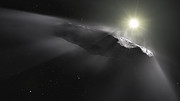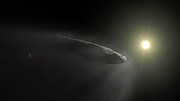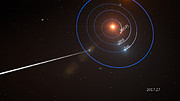An artist rendition of comet C/2014 UN271, the largest known comet in the Oort Cloud
Credit: NSF/AUI/NSF NRAO/M.Weiss. Hi-Res File
Credit: NSF/AUI/NSF NRAO/M.Weiss. Hi-Res File
Giant comet’s molecular activity and chemistry detected at record distance
A team of astronomers has made a groundbreaking discovery by detecting molecular activity in comet C/2014 UN271 (Bernardinelli-Bernstein)—the largest and second most distantly active comet ever observed from the Oort Cloud. Using the powerful Atacama Large Millimeter/submillimeter Array (ALMA) in Chile, researchers observed this giant comet while it was more than halfway to Neptune, at an astonishing distance of 16.6 times the distance between the Sun and Earth.
C/2014 UN271 is a true behemoth, measuring nearly 85 miles (140 km) across—more than 10 times the size of most known comets. Until now, little was known about how such cold, distant objects behave. The new observations revealed complex and evolving jets of carbon monoxide gas erupting from the comet’s nucleus, providing the first direct evidence of what drives its activity so far from the Sun.
“These measurements give us a look at how this enormous, icy world works,” said lead author Nathan Roth of American University and NASA Goddard Space Flight Center. “We’re seeing explosive outgassing patterns that raise new questions about how this comet will evolve as it continues its journey toward the inner solar system.”
The ALMA telescope observed C/2014 UN271 by capturing light from carbon monoxide gas in its atmosphere and heat (thermal emission) when the comet was still very far from the Sun. Thanks to ALMA’s high sensitivity and resolution, scientists could focus on the extremely faint signal from such a cold, distant object. Building on previous ALMA observations (Lellouch+2022, A&A, 659, L1) which first characterized the large nucleus size of UN271, these new findings measured the thermal signal to further calculate the comet’s size and the amount of dust surrounding its nucleus. Their values for the nucleus size and dust mass are in agreement with previous ALMA observations and confirm it as the largest Oort Cloud comet ever found. ALMA’s ability to precisely measure these signals made this study possible, offering a clearer picture of this distant, icy giant.
The discovery not only marks the first detection of molecular outgassing in this record-setting comet, but also offers a rare glimpse into the chemistry and dynamics of objects originating from the farthest reaches of our solar system. As C/2014 UN271 approaches the Sun, scientists anticipate that more frozen gases will begin to vaporize, revealing even more about the comet’s primitive makeup and the early solar system. Such discoveries help answer fundamental questions about where Earth and its water came from, and how life-friendly environments might form elsewhere.
C/2014 UN271 is a true behemoth, measuring nearly 85 miles (140 km) across—more than 10 times the size of most known comets. Until now, little was known about how such cold, distant objects behave. The new observations revealed complex and evolving jets of carbon monoxide gas erupting from the comet’s nucleus, providing the first direct evidence of what drives its activity so far from the Sun.
“These measurements give us a look at how this enormous, icy world works,” said lead author Nathan Roth of American University and NASA Goddard Space Flight Center. “We’re seeing explosive outgassing patterns that raise new questions about how this comet will evolve as it continues its journey toward the inner solar system.”
The ALMA telescope observed C/2014 UN271 by capturing light from carbon monoxide gas in its atmosphere and heat (thermal emission) when the comet was still very far from the Sun. Thanks to ALMA’s high sensitivity and resolution, scientists could focus on the extremely faint signal from such a cold, distant object. Building on previous ALMA observations (Lellouch+2022, A&A, 659, L1) which first characterized the large nucleus size of UN271, these new findings measured the thermal signal to further calculate the comet’s size and the amount of dust surrounding its nucleus. Their values for the nucleus size and dust mass are in agreement with previous ALMA observations and confirm it as the largest Oort Cloud comet ever found. ALMA’s ability to precisely measure these signals made this study possible, offering a clearer picture of this distant, icy giant.
The discovery not only marks the first detection of molecular outgassing in this record-setting comet, but also offers a rare glimpse into the chemistry and dynamics of objects originating from the farthest reaches of our solar system. As C/2014 UN271 approaches the Sun, scientists anticipate that more frozen gases will begin to vaporize, revealing even more about the comet’s primitive makeup and the early solar system. Such discoveries help answer fundamental questions about where Earth and its water came from, and how life-friendly environments might form elsewhere.
About NRAO
The National Radio Astronomy Observatory (NRAO) is a facility of the U.S. National Science Foundation, operated under cooperative agreement by Associated Universities, Inc.
About ALMA
The Atacama Large Millimeter/submillimeter Array (ALMA), an international astronomy facility, is a partnership of the European Southern Observatory (ESO), the U.S. National Science Foundation (NSF) and the National Institutes of Natural Sciences (NINS) of Japan in cooperation with the Republic of Chile. ALMA is funded by ESO on behalf of its Member States, by NSF in cooperation with the National Research Council of Canada (NRC) and the National Science and Technology Council (NSTC) in Taiwan and by NINS in cooperation with the Academia Sinica (AS) in Taiwan and the Korea Astronomy and Space Science Institute (KASI).
ALMA construction and operations are led by ESO on behalf of its Member States; by the National Radio Astronomy Observatory (NRAO), managed by Associated Universities, Inc. (AUI), on behalf of North America; and by the National Astronomical Observatory of Japan (NAOJ) on behalf of East Asia. The Joint ALMA Observatory (JAO) provides the unified leadership and management of the construction, commissioning and operation of ALMA.
ALMA construction and operations are led by ESO on behalf of its Member States; by the National Radio Astronomy Observatory (NRAO), managed by Associated Universities, Inc. (AUI), on behalf of North America; and by the National Astronomical Observatory of Japan (NAOJ) on behalf of East Asia. The Joint ALMA Observatory (JAO) provides the unified leadership and management of the construction, commissioning and operation of ALMA.
























